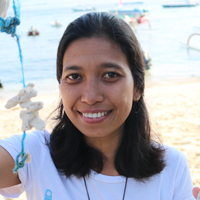She believes kids are the key to a cleaner future, and she’s developed a curriculum that inspires them to change their consumption habits. Meet Henri Frilia of Bottle for Botol.

A: Youth will grow up one day and rule. They will be able to take action and make decisions for their life, their family, their neighborhood, and their country. If they learn to be kind to each other and nature and to take positive action, the future will be better than today.
A: I have to motivate myself first to act! This is the most challenging and probably the hardest part about my job. Slowly but surely, what I do will motivate the teachers, and they will motivate their students. Children do what they see. Their behavior is formed from what they see and learn from their surroundings. If we keep setting good examples for children, they will act better than we do.
A: I think good lesson plans must have three primary goals, which are to:
Measuring the first goal is the easiest. We can check students’ workbooks, quizzes, or tests. However, measuring the second and the third goals takes longer (maybe even a lifetime).
Bottle for Botol is focused on reducing single-use plastic through environmental education, so we have a monitoring and evaluation team who regularly visits our schools to talk to the kids, teachers, and staff to see the significant outcomes of our projects.
It’s a good sign when we meet children who bring their own water bottles to school and refill them at school instead of buying water from plastic cup or plastic bottles. When we ask why, we know our lesson met its goal when they are able to explain the reason, no matter how simple it is. They may say they want to reduce single-use plastic, or to help little fish in the ocean, or to clean the environment. As long as they understand why they are doing an action, it means there is awareness.
A: It is important to do an ice breaker with kids to make sure they are comfortable and confident enough to do the lesson. Learning and discussion about environmental issue should be fun and cool. Children learn better when they are happy and cheerfully enjoying the learning process.
Even if we are talking about sad fish trapped in plastic bag in the deep blue sea, when children are in a happy mood, they listen and feel better.
A: I like doing free discussions with kids about what is bad and what is good for their schools or their village. Invite kids to think critically about their environment and earth. It is always interesting and surprising to know their thoughts and ideas. I have learned not to underestimate children. They can be smarter and wiser than we think!
A: My favorite lesson is about the trash journey.
Children pick one item they used to consume in a single-use container. Then, they draw the journey of this item while thinking about where it came from, how far it traveled to their home, how it traveled, and where it goes after they are done with it. Does it goes to landfill? The ocean? Or to be burned? Children also have to consider how often they consume that item to figure out how much they contribute to the total trash in the world.
This lesson teaches us to have self reflection—every single one of us contributes to the trash problem. The concept “I contribute to the trash problem” will help a child think about what he or she can do as an individual to reduce waste in their community.
Featured Photo: Henri Frilia coordinates environmental education programs for children with Bottle for Botol by Acacia BetancourtFind exactly what you're looking for in our Learn Library by searching for specific words or phrases related to the content you need.